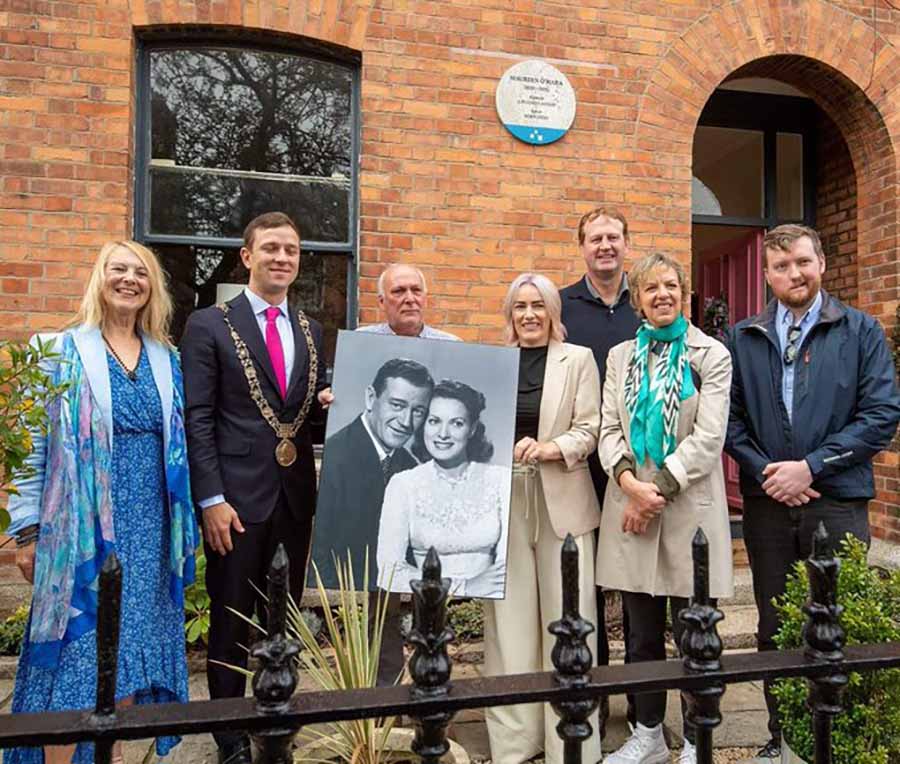
Number 32 Beechwood Avenue in Ranelagh has been honoured with a commemorative plaque recognizing it as the childhood home of iconic Irish actress Maureen O’Hara, unveiled by Lord Mayor James Geoghegan.
Mayor Geoghegan expressed pride in commemorating O’Hara, highlighting her unique achievements in Hollywood as an Irish actress during her time and recalling her attendance at the Ranelagh Arts Festival in 2010.
Professor Ruth Barton of Trinity College Dublin emphasised O’Hara’s pioneering role as a woman in cinema and her significant legacy, mentioning her prominent films like The Quiet Man and Miracle on 34th Street.
The plaque installation is part of Dublin City Council’s initiative to celebrate notable Dubliners and was proposed by Councillor Dermot Lacey.
James Geoghegan’s speech
I am delighted to be here today to unveil this Dublin City Council commemorative plaque for Maureen O’Hara and to mark the site of her birthplace.
It is a long overdue honour to someone who met with so much critical and popular acclaim in her lifetime and who remains today, in many eyes, the greatest actor to emerge from this island.
In someways we can be confident the scale of her achievements can never be repeated. At the height of her fame, she strode a world dominated by Hollywood and American cinema to an extent which is hard to imagine today. If anybody was asked in 1954 who was the most famous Irish person of all, they would have been in no doubt that it was Maureen.
To have a genuinely Irish female icon, respected and loved around the world for positive and respectful reasons, resonated with and inspired a generation of Irish women, artists, writers, musicians, designers and actors. She made being Irish fashionable in a way that it had never have before. She mad being an Irish woman fashionable. Everything that happened afterwards for Irish people across cinematic and popular culture leads back, in some small and obscure way, to Maureen O’Hara.
Most of the details of her life are well known, and not just to film buffs.
The bits that are not so well known are no less intriguing. Her father was named for Charles Stewart Parnell. He was part-owner of Dublin’s Shamrock Rovers FC, which rose dramatically from obscurity under his patronage to become the most successful club in the League of Ireland.
Today, you can see his Shamrock Rovers director’s card is in the museum in Foynes, a museum opened by Maureen in a town made famous by Maureen’s beloved third husband Charles Blair, a flying boat pilot who flew there regularly between 1942 and 1945 and who helped compile the first navigation aids for long distance flying.
Maureen supported Shamrock Rovers through her life, and would no doubt be proud of their record in Europe this season.
Her memoir tells of a happy childhood in the leafy suburbs, playing the tomboy she always remained at heart, climbing trees and fishing in the Dodder. She wrote that she was born into the most remarkable and eccentric family she could possibly have hoped for. Her parents were clothes designers, her siblings all entered theatre, music and drama at different levels.
Primary school was John Street West across the road from Vicar Street, a building now part of the NCAD complex, and St Anne’s in Miltown, also now closed. I dainty little lass she wasn’t. She said she looked twice her age until she turned 10 or 11. She gave her first performance at a school concert at the age of six. Excited by the stage, her parents enrolled her in Ena Mary Burke School of Elocution and Drama at 20 Kildare Street, where Milo O’Shea, and later Joe Dowling and Brenda Fricker trained. Before she was 14 had appeared in radio dramas on 2RN, later Radio Éireann. She had a great face for radio, or so she was told, as she was said to have a sulky, pouty face.
In her teens she joined the Abbey theatre, serving an apprenticeship that included set building and cleaning, slowly progressing to parts with one or two lines. Harry Richman, the American comedian who discovered her at 17 years of age, invited her to a screen test in London for his musical comedy Kicking the moon around. The film, a chaotic love triangle, is forgotten today apart from the 17 year old who delivered her first screen line, just one single line, in the film.
A year later, she appeared in film that made her a star, Jamaica Inn. By then she had a new name, given to her by Hollywood because they thought “Fitzsimons” was too long.
Then two things happened. In 1942, technicolour was invented. Striking red hair, hazel eyes and pale skin, Maureen was made for the new medium.
In the words of the all powerful Hollywood gossip columnists of the time, she became the Queen of Technicolour .
The second thing that happened came in 1950 John Wayne was cast opposite her for the first time. She went on to play a feisty wife to her onscreen husband in five films in all, and he became her closest friend in Hollywood.
Being beautiful had its unexpected drawbacks. Many of her films are forgettable. Late in life, she said that she resented not getting a crack at more dramatic roles because she photographed so beautifully. The woman who wanted to be an opera soprano was not permitted to sing. Her memoir reveals how she was exploited, betrayed and disappointed by the movie world. Poor quality roles helped explain why she never received an Academy Award or received an Oscar nomination, “Lost in a crowd of greats, not a single Oscar, that’s showbiz,“ she said. But things were put to rights when she was granted an honorary Oscar in 2014, just before her death in 2015 was mourned by the cinema community around the world, described to the end as the queen of technicolour.
The release of the Quiet Man in 1952 had enormous repercussion for our city and still young country. The image conveyed to American popular culture that helped create our tourism industry, long before the phrase set-jetting was invented.
When Americans started arriving in large numbers to seek out the landscapes of the Quiet Man, there were few hotels to accommodate them, so Ireland’s legendary bed and breakfast industry was created by the wives of the farmers and fishermen, all heroic Maureen O’Hara figures in their own small way.
Aer Lingus launched direct trans-Atlantic flights six years later, our national airline able to compete with the big guys for the first time.
Back at her birthplace in Dublin in September, we are happy to remember the queen of Technicolour for what she was, a woman who overcame obstacles and conquered the world on her terms, the most famous Irishwoman of her time and for a long time to come.
My heritage, she wrote late in life, has been my grounding, and it has brought me peace.
In conclusion, I would like to thank you all for coming along here today. And I look forward to unveiling this plaque to Maureen O’Hara.



